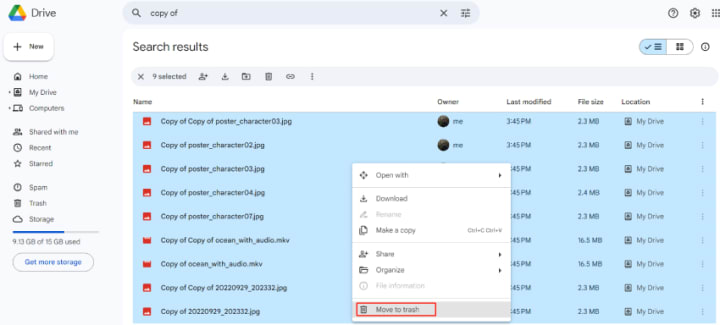Delete Duplicate Google Drive Files
Strategies and Tools to Identify, Remove & Prevent Duplicate Files in Google Drive

Say Goodbye to Duplicate Google Drive Files
Got a bunch of duplicate files clogging up your Google Drive? It's a common issue, but luckily there are some nifty ways to tackle it, from doing it the old-fashioned way to using handy tools that do the heavy lifting for you.
Why Do Duplicate Files Even Happen?
Here are some common culprits behind those pesky duplicates:
- Software Installations: They like to copy the same files to avoid problems if you uninstall or update a program. Each one keeps its own copies of shared files to stay in control.
- Windows: It duplicates system files for protection and backups, like through System File Protection which restores files if something goes haywire. Older versions of Windows can also leave a Windows.old folder after an update.
- App Updates: Some apps save old versions of files when they update or keep duplicate copies to track changes. Multiple versions of a program might lead to unchanged files being duplicated too.
- User Actions: Sometimes, you might copy files for different scenarios or use "Save As" to create a new file with the same content. This is less common than the duplicates created by software, but it happens.
While they seem like a nuisance, these duplicates often serve legit purposes, like ensuring programs run smoothly and providing backups.
Use a Google Drive Add-on for Duplicate Removal

Enter Filerev, the hero you didn't know you needed for clearing out duplicates in Google Drive. Once you install this add-on and grant it access, it gets to work scanning your files and folders.
It shows you exactly how many duplicates you've got and how much space they're hogging. Then you can choose to delete duplicates one by one, in batches, or all at once using the Bulk Delete tool. Plus, you can decide whether to keep the oldest or newest copy of a file, and use advanced filters to target specific duplicates, like those owned by certain people or older than a set date.
Filerev also helps you organize your Drive by finding large files, hidden files, and old files, and analyzing storage across folders. It's a pretty sweet way to keep your Google Drive in check.
Best Practices for Preventing Duplicate Files

Want to avoid duplicates altogether? Here are some tips:
Unique File Names: Use descriptive names to avoid accidentally creating duplicates with different names. Stick to a consistent naming convention.
- Centralized Storage: Keep files in a shared drive or content management system instead of local copies. This ensures everyone accesses and edits the same file.
- Version Control: Use version control software for frequently changing documents. This keeps a single file while preserving its revision history.
- User Training: Teach users how actions like "Save As" can create duplicates. Encourage renaming files instead of copying them.
- Regular Scans: Run deduplication scans regularly with third-party tools and automate the process if possible.
- External Backups: Keep critical files backed up externally so originals can be restored without cluttering the main storage.
These practices can help keep duplicate files at bay and your storage neat and tidy.
Manually Remove Duplicates in Google Drive

Prefer to do it yourself? Here's how:
1. Open Google Drive and go to the folder with potential duplicates.
2. Sort files by name to group similar ones.
3. Scan through the list for duplicates. Look for files with the same name but different versions, like "Report (1).docx" and "Report (2).docx".
4. Verify the content of potential duplicates.
5. Delete the duplicates by selecting the version you don't need, right-clicking, and choosing "Remove".
This method is time-consuming and error-prone, especially if you have a lot of files. An automated tool like Filerev can save you loads of time.
Manually Search for Duplicate Files in Google Drive
Want to manually hunt down those pesky duplicate files in Google Drive? Here’s a quick guide to get you started:
- Use the Search Bar: Pop up to the search bar at the top of your Drive and type in common terms like "copy", "duplicate", "version", or "final." These keywords usually flag duplicates hiding in plain sight.
- Filter by Owner: Narrow down your search results by using the "Owner" filter. This lets you see files owned by you or your colleagues who might’ve duplicated files. You can also filter by file type if you think the duplicates are mostly images, PDFs, or any specific format.
- Sort by File Size: Arrange the filtered results by file size. Files with the same size are often duplicates, so this makes it easier to spot them when they’re grouped together.
- Compare Content: Open the files you suspect are duplicates and give them a quick once-over to ensure they’re identical before you hit delete. Sometimes, similarly named files can have slight variations you don’t want to miss.
While this method works, it does require some memory gymnastics to recall all the keywords and apply the right filters. Plus, it won’t help with duplicates that have completely different names or are owned by someone else with a different naming style. For a more thorough and automatic cleanup, consider using a tool like Filerev designed to sniff out duplicates for you.
Does Google Drive Automatically Handle Duplicates?
Unfortunately, Google Drive doesn't automatically detect and manage duplicate files. When you upload a file with the same name as an existing one, it just lets both files coexist without any alerts. This can lead to confusion and clutter.
To manage duplicates, you'll either need to search manually or use a third-party tool. Tools like Filerev can scan your Drive for duplicates and help you remove them efficiently. They can also automatically delete the oldest versions or filter results by date or owner.
How Much Storage Space is Used by Duplicates?
Clearing out duplicate files can free up a ton of space. For instance, if you have 100 duplicate files that are 1MB each, deleting them gives you back 100MB of space. Larger duplicates, like videos or high-res images, can save you even more space.
Running a scan with Filerev reveals how many duplicates you have and how much space they’re wasting. Many users are shocked to find gigabytes of redundant files. Removing these frees up space for other files and helps you avoid hitting storage limits or upgrading to a paid plan.
Plus, having only one copy of each file makes your Drive easier to navigate and manage. You’ll spend less time figuring out which file is the most recent or accidentally working on the wrong version.
So, regularly cleaning out duplicates is a smart way to keep your Google Drive organized and make the most of your storage.
About the Creator
Jordan Blake
I'm a tech enthusiast with a computer science background and over five years in the tech industry. I simplify complex tech concepts, making them accessible. Outside of tech, I enjoy the outdoors, cooking, and community tech meetups.
Enjoyed the story? Support the Creator.
Subscribe for free to receive all their stories in your feed. You could also pledge your support or give them a one-off tip, letting them know you appreciate their work.






Comments
There are no comments for this story
Be the first to respond and start the conversation.